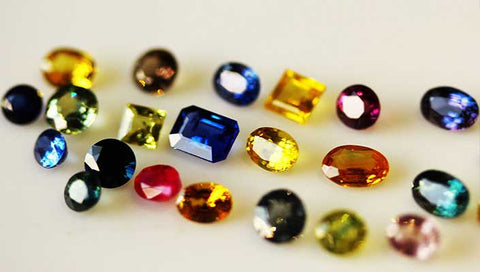Here, we are discussing about evaluation of colored stones as loose gemstones or in cut form. How faceted stones or loose gemstones for sale should be analysed while buying. What are key factors that a gem buyer should keep in mind before making final purchases of the stones which are already cut or faceted, being ready to fix in the jewelry. There are many key points about setting pricing or value of a stone. Some of the popular factors, defined by gemologists and trade gemstone dealers, are listed below. They are
- Color
- Clarity
- Size
- Cut
- Location of the Stones
- Treatment of the Stone
- Stone Type Precious or Semi Precious
- Demand Intensity of the Stone
Following chart is indicating the importance of these factors in percentage.

1- Color
Color is always considered as a “ king “ in the colored stones. There are some dimensions in the colored stones regarding their color evaluation. Those are
- hue (yellow, green, red, green, blue, etc)
- saturation (intensity of a color)
- and tone (lightness or darkness)
- uniformity of color
The optimum color range of each stone is different. Pale colors usually have low value. Though pale green colored stones from Afghanistan and Pakistan such as tourmaline is high demanded stone. Gemstones get color by inclusion of specific trace elements in them.
Role of Trace elements Giving Colors to the Gemstones:-
Titanium: Blue
Chromium: Red – Green
Vanadium: Green / Color change
Manganese: Pink
Iron: Red – Green – Yellow
Cobalt: blue
Nickel: Green
Copper: Green - Blue
Color of the stones should be open. Darkest tone of the stone gives lower value to the stone.
Open color is a market term used by gemstone dealers. Open color means tone of the color. How much the stone is dark or light in the color. Darkest shade of the stone made them less in value as they go close to the blackish tone side. In colored stone, it is the color only that define the value of a stone.
2- Clarity of the Colored Stones
The clarity of colored stones serves as a reflection of both their internal and external quality. Assessing clarity involves examining both the outward appearance and internal characteristics of faceted stones. External clarity is evaluated by identifying flawless surfaces on the table, pavilion, and facets. Meanwhile, internal analysis reveals insights into any inclusions present within the stone, such as cracks or other imperfections. Questions regarding clarity often center around the presence, type, and quantity of inclusions, as well as whether the stone is entirely flawless.
Stones are divided into following scale of clarity.
- Eye Clean = no inclusion visible to naked eye though visible under loop - inclusions cannot be seen without magnification
- Loop Clean = no inclusion seen under 10x loop
- S= Slight Included
- VS= Very Slightly Included
- VVS= Very Very Slightly Included
Inclusions in the colored stones | Loose Gemstones
Some gemstones are having inclusions always. Some are commonly eye - clean. Sometime inclusions increases the value of a stone. Such as Kashmir Sapphire's resulting velvet appearance that occurs due to internal inclusion which gets light reflection.
Stones Identification By Internal Inclusion Types Observations Read more....
Star Sapphires are another example. Inclusions cause star in sapphires, rubies or tripeche in emeralds. Star sapphires are also expensive in the market if they are in fine quality. Sometimes, the stones have unique and rare inclusions. Such type of inclusions is also acceptable by the gemstone dealers. Such pieces are sold to gemstone collectors. Sunstone is another example of beautiful inclusions. Cats Eye stones also reflect beautiful eye light moving brilliance that is caused by internal inclusion and light reflection to the inclusions.
Some gemstones are not cleared which are cut into cabochons or tumbled. They are most of the time opaque.
3- Size & Weight of Colored Stones
The dimension of a gemstone stands as another pivotal aspect in assessing colored stones. Size emerges as a key factor in evaluating these gems. The inquiry often revolves around the carat weight: Is it 1 carat, 2 carats, or perhaps 4 carats? Typically, the larger the stone, the steeper its price tag, while smaller stones tend to be more budget-friendly.
Moreover, demand dynamics heavily influence size considerations. In jewelry crafting, particularly in designs necessitating uniformly sized calibrated stones, the predetermined millimeter measurements become non-negotiable benchmarks.
There are many calibrated stones in mm size which are pricy per carat such as rainbow sapphires, emeralds in mm size to be fixed in watches like Rolex or rubies. The cutting of small size colored stones in mm scale is very very difficult. They will be highly expensive if cut in round diamond cut or round brilliant cut.
4- Cut of Colored Stones
The art of cutting colored stones holds equal significance alongside other defining traits. A skilled cut can elevate the worth of an inferior raw gem, whereas a subpar cut can depreciate the value of a superior one. The finer the cut, with consistent facets, the more modest the price tends to be.
Evaluation of gemstone cutting involves five major factors. Those are below mentioned.
- Shape
- Cutting style
- Proportions
- Symmetry
- Finish
1- Shape of colored stone
Stones are evaluated by shapes also. Demand of specific shapes and cutting styles of colored stones is changing day by day. They have evolved to that in different type of shapes which are here.

The popular gemstone shapes are ovals, round and emerald cuts. Pears and Marquises are less desirable shapes in the colored stones. They are traded about 10 to 20% less than oval shapes of same quality. However, the shape of cut stone depend on rough stone shape also. In order to save weight, rough stones are cut into similar shape.
There are some gemstones which go for only specific shapes such as tourmaline, emeralds due to their specific hexagonal crystal structure. If we will cut them into oval or round shape, we will loss maximum weight after cutting. Mostly emeralds and tourmaline is cut into emerald cut, square, or octagon shapes.
2- Faceting Style or Cutting Style of Colored Stones
The faceted pattern is a subjective choice which is also called a cutting style of the gem. The brilliant crown and step pavilion is a market standard for sapphires and rubies. Emeralds are cut into step cutting.
3- Proportions of the Stone
Faceted cutting is done to gain maximum brilliance in a symmetrical manners. Symmetry of the cutting is very very important. There are two parts in faceted gemstones which are Crown and Pavilion.



4- Symmetry of Colored Stone
Fine cut gemstone will catch our eyes immediately. Symmetry of stone is done by creating equal proportion of the cutting. Some types of bad symmetry of cutting or faceted gemstones are here below:-
- Poor crown/pavilion alignment
- Asymmetrical girdle outline
- Overly narrow/wide shoulders (pears and heart shapes)
- Overly thick/thin girdle
- Table not parallel to girdle plane
- Off-center culet
- Off-center table facet
- Overly narrow/deep cleft (heart shapes)
- Wavy girdle
5- Finishing of the Stone
The final touch comes to polishing of the stone. After good faceting, polishing of stone matters a lot. Final touch also refer to fine tuning of facets, polishing
5- Location of Loose Gemstones for Sale
In defining value of faceted gemstones, location of the stone also matters a lot. In fact stones are priced according o region. In blue sapphires, Kashmir sapphire is a standard due to its specific geological occurrence in a specific geological location. Burma Spinels and Burma rubies are popular in rubies and spinels. Paraiba tourmaline is popular for Brazil Paraiba tourmaline.
Lapis from Afghanistan, Peridots from Pakistan, Aquamarine Crystals from Pakistan, exceptional quartz varieties from Pakistan, Kunzite from Afghanistan, Swat Emeralds from Pakistan, Australian Opals, Ceylon Sapphires, Brazilian Amethyst, Citrine are popular due to their locations and origin.
5- Treatment of The Faceted Stones
Treatment of the stones affect the pricing of cut stones. Natural stones are highly demanded. They should be without any kind of treatment. There are different types of treatment in the market. Heat treatment is the most popular treatment for many gems.
Standard heat treatment is acceptable in the market. However, beryllium heated stones like red or orange sapphires is not counted as normal heat. Other treatment like filling fractures by wax in turquoise, glass in sapphires and rubies, oil in emeralds is highly discouraged by the gemstone traders in the market. Some sapphires and rubies are glass filled in cabochon form. Some emeralds are treated with resin, wax or green oiled which is extremely not acceptable in the market. Baby oil in emerald is acceptable which can be even removed by acetone. Baby oil is put into emeralds in rough in order to avoid frictions.
6- Stone Type Precious or Semi Precious
Precious stones have more value than semi precious stones. Precious stones include sapphires, rubies, emeralds normally. Semi precious stones include peridots, amethysts, topaz, garnet, citrine, quartz etc.
7- Demand Intensity of the Cut Stone
Trends in gemstone and jewelry industry define the price of the stone. The birthstones are more demanding stones in a particular month. Wedding season normally comes from September to March. In this season, engagement and wedding rings are sold than other days. Engagement rings normally include diamonds, sapphires, rubies, emeralds, amethyst, spinels, rare garnets, imperial topaz, morganite, paraiba tourmaline, bi color tourmaline, peridots or some rare semi precious stones such as color change stones.






0 comments